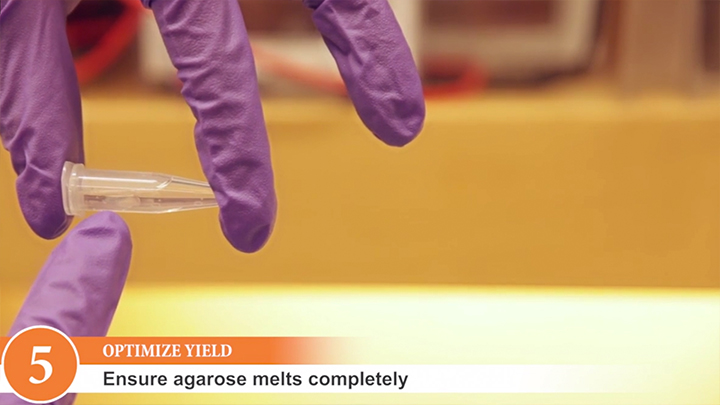Monarch® DNA Gel Extraction Kit Protocol (NEB #T1020)
General Guidelines:
The input amount of DNA to be purified should not exceed the binding capacity of the column (5 μg). DNA fragments are excised from an agarose gel and are diluted by addition of four volumes of Gel Dissolving Buffer. For a typical 100 mg (100 μl) gel slice, 400 μl of Gel Dissolving Buffer is added. Centrifugation should be carried out at 16,000 x g in a standard laboratory microcentrifuge at room temperature.Buffer Preparation:
Add ethanol to Monarch DNA Wash Buffer prior to use (4 volumes of ≥ 95% ethanol per volume of Monarch DNA Wash Buffer).- For 50-prep kit add 20 ml of ethanol to 5 ml of Monarch DNA Wash Buffer
- For 250-prep kit add 100 ml of ethanol to 25 ml of Monarch DNA Wash Buffer
Protocol:
All centrifugation steps should be carried out at 16,000 x g (around 13K RPM in a typical microcentrifuge). This ensures all traces of buffer are eluted at each step.- Excise the DNA fragment to be purified from the agarose gel using a razor blade, scalpel or other clean cutting tool. Use care to trim excess agarose. Transfer it to a 1.5 ml microcentrifuge tube and weigh the gel slice.
Note: Using UV light to visualize the slice is common, but exposure time should be kept as short as possible to minimize damage to the DNA. Use long-wave UV when possible, as shorter wavelengths induce greater damage. Also, trim off excess agarose from the perimeter of the band to minimize the amount of dissolving buffer needed, and to reduce the time necessary to extract the DNA.
- Add 4 volumes of Monarch Gel Dissolving Buffer to the tube with the gel slice (e.g., 400 μl buffer per 100 mg agarose). If the gel slice is >150 mg, consider reducing the amount of Gel Dissolving Buffer to 3 or 3.5 volumes to minimize the guanidine salt present in the workflow.
Note: If the volume of the dissolved sample exceeds 800 μl, the loading of the sample onto the column should be performed in multiple rounds to not exceed the volume constraints of the spin column.
- Incubate the sample between 37–55°C (typically 50°C), inverting periodically until the gel slice is completely dissolved (generally 5–10 minutes).
Note: For DNA fragments > 8 kb, an additional 1.5 volumes of water should be added after the slice is dissolved to mitigate the tighter binding of larger pieces of DNA (e.g., 100 mg gel slice: 400 μl Gel Dissolving Buffer: 150 μl water). Failure to dissolve all the agarose will decrease the recovery yield due to incomplete extraction of the DNA and potential clogging of the column by particles of agarose.
- Insert the column into collection tube and load sample onto the column. Spin for 1 minute, then discard flow-through.
 To save time, spin can be reduced to 30 seconds.
To save time, spin can be reduced to 30 seconds.
 If using a vacuum manifold* instead of centrifugation, insert the column into the manifold and switch the vacuum on. Allow the solution to pass through the column, then switch the vacuum source off.
If using a vacuum manifold* instead of centrifugation, insert the column into the manifold and switch the vacuum on. Allow the solution to pass through the column, then switch the vacuum source off.
- Re-insert column into collection tube. Add 200 μl DNA Wash Buffer and spin for 1 minute. Discarding flow-through is optional.
 If using a vacuum manifold, add 200 μl of DNA Wash Buffer and switch the vacuum on. Allow the column solution to pass through the column, then switch the vacuum source off.
If using a vacuum manifold, add 200 μl of DNA Wash Buffer and switch the vacuum on. Allow the column solution to pass through the column, then switch the vacuum source off.
- Repeat wash (Step 5).
- Transfer column to a clean 1.5 ml microfuge tube. Use care to ensure that the tip of the column has not come into contact with the flow-through. If in doubt, re-spin for 1 minute before placing into clean microfuge tube.
 If using a vacuum manifold: Since vacuum set-ups can vary, a 1 minute centrifugation is recommended prior to elution to ensure that no traces of salt and ethanol are carried over to the next step.
If using a vacuum manifold: Since vacuum set-ups can vary, a 1 minute centrifugation is recommended prior to elution to ensure that no traces of salt and ethanol are carried over to the next step.
* Make sure to follow the manifold manufacturer's instructions to set-up the manifold and connect it properly to a vacuum source.
- Add ≥ 6 μl of DNA Elution Buffer to the center of the matrix. Wait for 1 minute, and spin for 1 minute to elute DNA.
Note: Typical elution volumes are 6–20 μl. Nuclease-free water (pH 7–8.5) can also be used to elute the DNA. Yield may slightly increase if a larger volume of DNA Elution Buffer is used, but the DNA will be less concentrated. For larger size DNA (≥ 10 kb), heating the elution buffer to 50°C prior to use can improve yield. Care should be used to ensure the elution buffer is delivered onto the matrix and not the wall of the column to maximize elution efficiency.
 To save time, spin can be reduced to 30 seconds.
To save time, spin can be reduced to 30 seconds.

